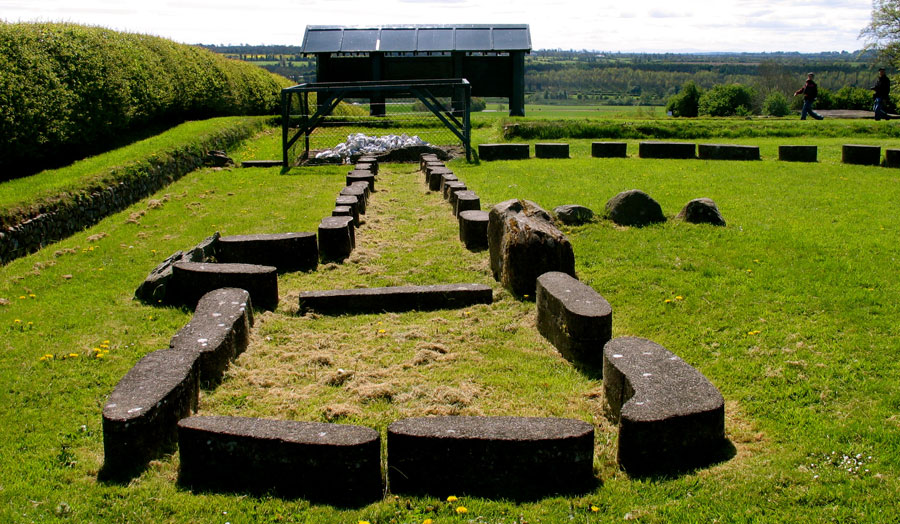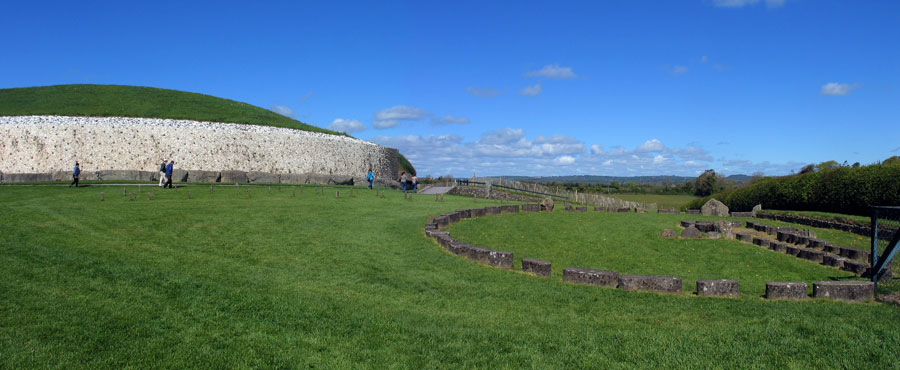Site Z at Newgrange
The Boyne Valley complex has about forty neolithic sites in total, all clustered around the three great passage-graves of Newgrange, Knowth and Dowth.
On the ridge along with Newgrange are the remains of three smaller neolithic satellite passage-graves, and it is suspected that there may have been a fourth. Two, Sites K and L are located in the field to the west of Newgrange. Also on the same ridge are two timber circles, which seem to be late neolithic or early bronze age wood-henges, and also and the remains of two cursus monuments.
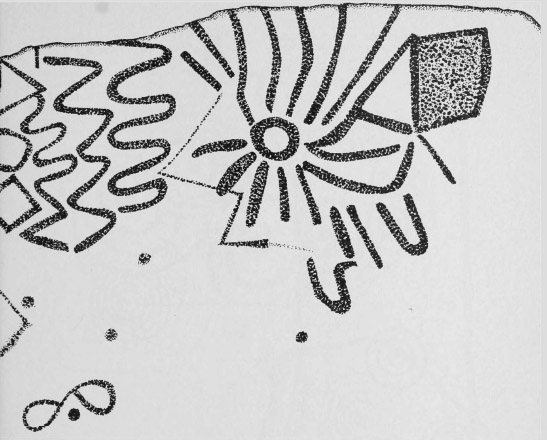
Little remains of the original stones of Site Z, which seems to have been destroyed during the 1820's by a Mr. Kirk who was occupying the land at that time. Michael O'Kelly made this comment about Kirk's activities:
'Site Z, on the other hand, was smashed up with the utmost ferocity. Every orthostat of the kerb and of the passage and chamber of the enclosed tomb that could be broken was smashed into small fragments, each a few centimetres across, and these were then thrown back into the sockets from which the orthostats had been pulled. Those which could not easily be broken, were overthrown and buried adjacent to their original positions . . . All of the damage was done to facilitate cultivation of the area . . .'Three Passage-Graves at Newgrange, Co. Meath, in 1978.
Site Z is located right beside and just east of Newgrange and within the large Bronze age circular enclosure of pits. Site Z was discovered during the excavations at Newgrange, and was itself excavated by Michael O'Kelly and his team in 1966. The site had been largely destroyed by ploughing: all this land belonged to Melifont Abbey and was intensively farmed in medieval times. O'Kelly described how the human remains seemed to have been collected and dumped in pits:
As the mound was being destroyed, unburnt human burials must have been encountered either in its upper part or in the upper part of the deposits in the chamber and passage. Skulls or skull fragments would have been recognisable amongst these bones. Three pits were dug outside the kerb through the corresponding turf and the skulls, mandibles and other recognisable human bones were thrown into them with masses of stone fragments from the broken up greywacke passage orthostats and kerb stones. The pits were then closed over with soil, in the upper layer of which was a considerable spread of quartz fragments. These must have come from the edge of Site Z in the entrance area.
Overlying two of the pits was a considerable area of burnt material. The top layer of the fill of the pits was oxidised to a bright red colour, some of the quartz fragments were heat-shattered and showed vitrified surfaces and there was much charcoal and some bone fragments. This may have been due to a burning of coarse vegetation and scrub taken from Site Z and probably from Site Z1 or whatever structure lies outside the Newgrange enclosure. The burnt area in turn was partly covered by a spread of water-rolled stones, cairn material which appeared to have derived from the postulated Z1 structure and which must have been in course of destruction at the same time. This stone layer was thick (maximum 60 centimeters) at the east and tailed off gradually to its western and southern edges. In its south-eastern part, it had been dug away completely in yet another disturbance of the soil. A considerable extension of the excavation would have been needed to follow up this disturbance, and it was decided not to undertake it.Three Passage-Graves at Newgrange, Co. Meath, in 1978.
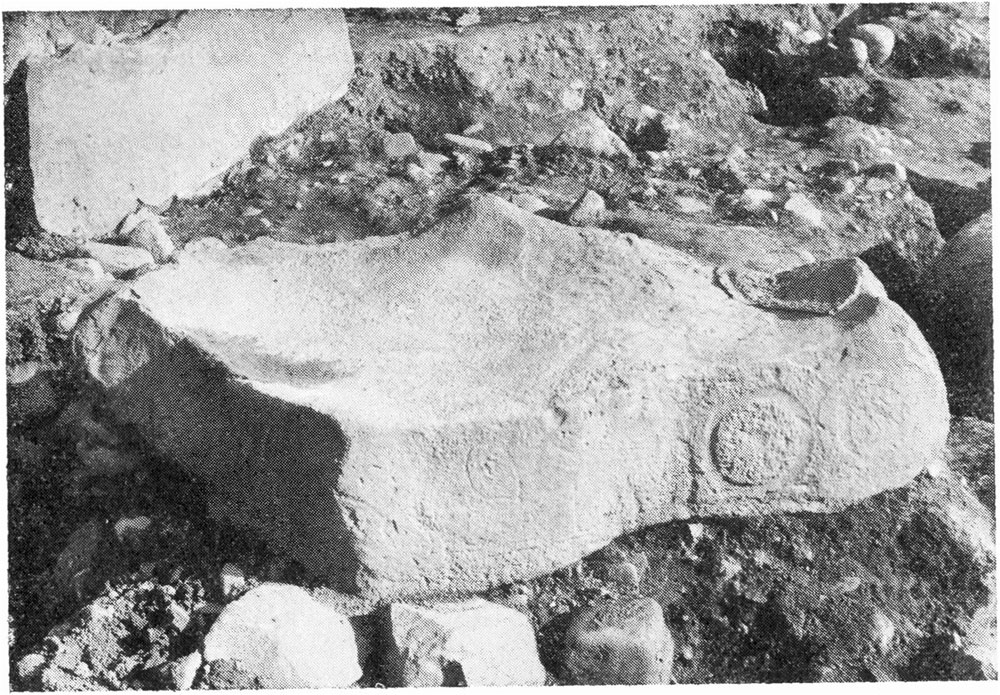
The monument is about twenty meters in diameter. The kerbstones had been removed long ago during land clearance, and their sockets have been marked with ugly concrete stumps, as have the missing passage and chamber stones. The passage is just under nine meters long, and opens into what may have been a large cruciform chamber; a small recess a meter square was found on the right hand side. The site was too disturbed to be sure if a left recess ever existed. An inner arc of five small boulders was found on the west side of the chamber.
The chamber contained a single basin stone, but this had been displaced from its original position. As found it lay adjacent to the sill stone socket but as its eastern end overlay the socket of one of the orthostats of the east side of the chamber, this cannot have been its original position though it may not have been moved very far. As found it was right side up and lying on top of it were two flat stones. Underneath them was a small spread of burnt human bone amongst which were found two barrel-shaped beads. Around its edges and under it were further amounts of burnt bone and other normal passage-grave objects. Perhaps, therefore, its original position was in the chamber just behind the sill stone.
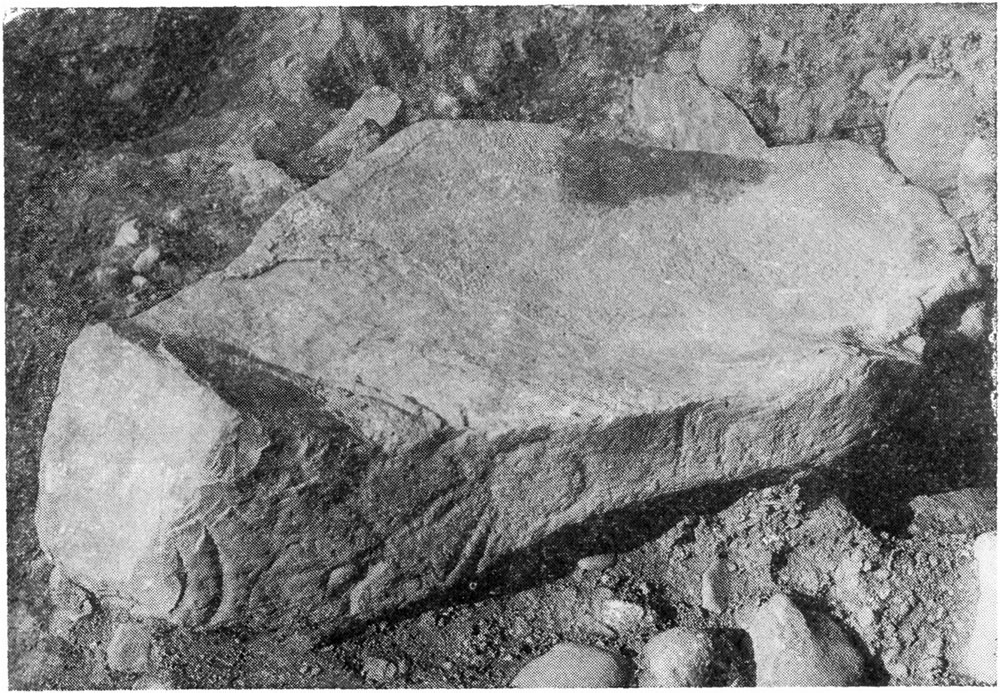
The basin stone was of irregular outline and no attempt had been made to shape this outline artificially. Its maximum length was l*35m and maximum width 95 centimeters. Its thickness was irregular and varied from 14 to 32cm. Its upper surface had been chiselled to form a shallow basin, its greatest depth about 3 centimeters. The chisel used was a medium-fine point. Near the mid-point of one edge and within the basin is a circular hollow or cupmark, 11 centimeters in diameter and about l.5 centimeters deep. This was first picked out and then rubbed. It may be compared to the pair of such hollows in the upper basin stone in the east recess at Newgrange. An unchiselled lipwas left around part of the rim but since a lamina had broken away from a large part of the surface in this area, it is probable that more of the lip was originally present. The interior of the basin is picked all over except where the lamina is missing. There was ornament on two edges.
Three Passage-Graves at Newgrange, Co. Meath, in 1978.
The most unusual find was the decorated stone basin, discussed above, which looks like a saddle quern, and contained cremated human remains. Some of the decorated stones from Site Z are in the National Museum in Dublin, where they have been reassembled in the passage grave exhibition. Two chalk marbles, a fragment of a bone pin and many pieces of flint were found in the passage during the excavation. Most interestingly, a stone chisel was found in the chamber, a very rare artifact. None were found at Knowth, where so much carving took place. Four beads, three more marbles and six bone pins were also found in the chamber.
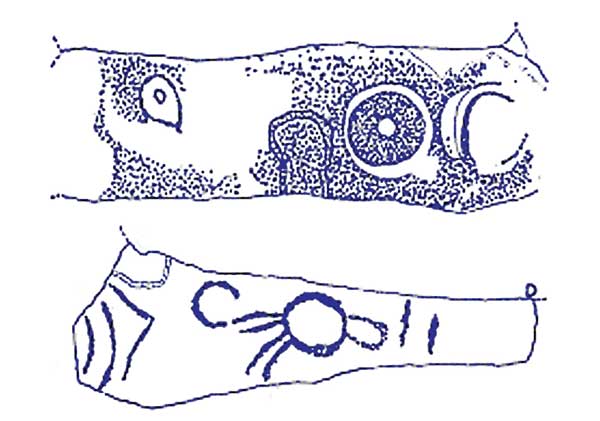
Martin Brennan believed that Cairn Z was a component of a suite of alignments and observations whichtook place in the Boyne Valley over the winter solstice:
The scenario in the Boyne Valley is far more complex than expected: it involves the sun’s rays entering Newgrange at dawn (8.$4 a.m.), mound Z at 10.1$ and mound K at 1 1.20, remaining there until 12.26 Green wich Mean Time (equivalent to noon local apparent time). Immediately afterwards the beam would enter mound L, remaining there until 1.09. Between 1.09 and 2.20, when a thin shaft of light appears in the chamber of Dowth 2, the sun’s rays may have illuminated mound Z1, adjacent to Z. This mound has been completely destroyed, although there is some evidence of it in aerial photographs.
By 2.53 the light beam has moved to the back of the Dowth chamber. Reflected light illuminates stone 13 in the side chamber from 3.04 until 3.30. Light is cut off from Dowth at 4.03, when the sun’s disc begins to disappear below the horizon. T h e sun sets at 4.07. The intention seems to be continual observation of the sun throughout the shortest day of the year. Satellites aligned due south appear to be a feature of other major complexes. Cairn T on Loughcrew has one and Knowth also has at least one.
Sites K, L and Z all seem oriented to follow the progression of the sun across the sky on the shortest day of the year, and of course they would also have been used for lunar and other observations.

